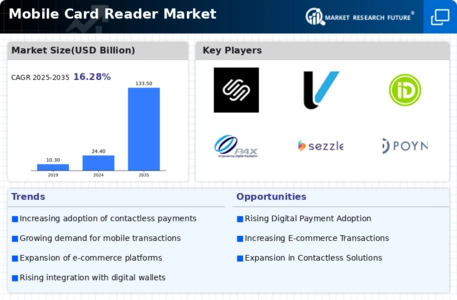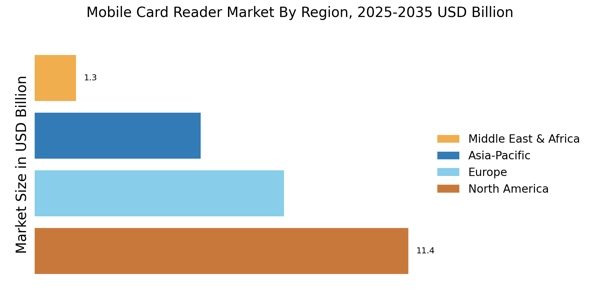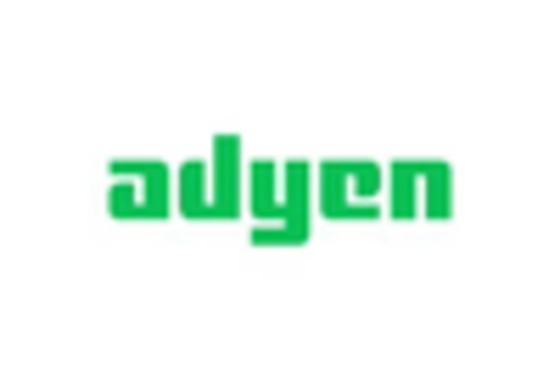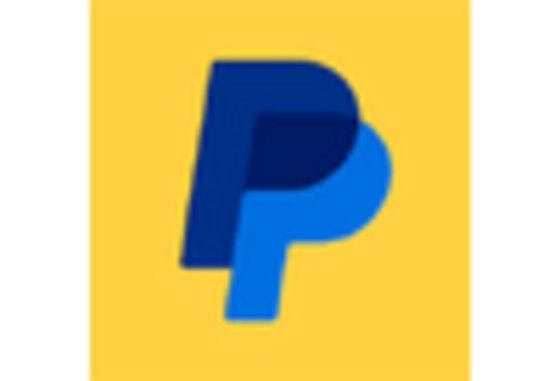Expansion of E-commerce Platforms
The Mobile Card Reader Market is significantly influenced by the expansion of e-commerce platforms, which have transformed the retail landscape. As online shopping continues to gain traction, businesses are increasingly adopting mobile card readers to facilitate transactions both online and in physical stores. The convenience of mobile payments is becoming essential for e-commerce merchants, who aim to provide a seamless shopping experience. Data suggests that e-commerce sales are expected to grow substantially, further driving the demand for mobile card readers. This trend indicates that businesses must adapt to the changing market dynamics by incorporating mobile payment solutions, thereby propelling the Mobile Card Reader Market forward.
Increase in Mobile Payment Adoption
The Mobile Card Reader Market is experiencing a notable increase in mobile payment adoption, driven by the growing preference for cashless transactions. As consumers increasingly favor convenience, the demand for mobile card readers has surged. According to recent data, mobile payment transactions are projected to reach trillions of dollars in the coming years, indicating a robust growth trajectory. This trend is further supported by the proliferation of smartphones and mobile applications that facilitate seamless payment experiences. Retailers and service providers are recognizing the necessity of integrating mobile card readers into their operations to cater to this evolving consumer behavior. Consequently, the Mobile Card Reader Market is likely to expand as businesses seek to enhance customer satisfaction and streamline payment processes.
Increased Focus on Customer Experience
The Mobile Card Reader Market is increasingly characterized by a heightened focus on customer experience. Businesses are recognizing that providing a seamless and efficient payment process is crucial for customer satisfaction. Mobile card readers facilitate quick transactions, reducing wait times and enhancing the overall shopping experience. As competition intensifies, companies are investing in mobile payment solutions to differentiate themselves and meet consumer expectations. Recent surveys indicate that a majority of consumers prefer businesses that offer mobile payment options, underscoring the importance of adapting to this trend. This emphasis on customer experience is likely to drive the growth of the Mobile Card Reader Market, as businesses strive to create a more engaging and convenient shopping environment.
Rising Demand for Small Business Solutions
The Mobile Card Reader Market is witnessing a rising demand for solutions tailored to small businesses. As entrepreneurs and small business owners seek efficient and cost-effective payment processing options, mobile card readers have emerged as a viable solution. These devices offer flexibility and portability, allowing small businesses to accept payments anywhere, thus enhancing their operational efficiency. Recent statistics indicate that a significant percentage of small businesses are adopting mobile payment solutions, reflecting a shift in payment preferences. This trend is likely to continue, as small businesses recognize the advantages of mobile card readers in improving customer engagement and streamlining transactions, thereby contributing to the growth of the Mobile Card Reader Market.
Technological Advancements in Payment Processing
The Mobile Card Reader Market is being propelled by technological advancements in payment processing. Innovations such as Near Field Communication (NFC) and chip card technology are enhancing the functionality and security of mobile card readers. These advancements not only improve transaction speed but also bolster consumer confidence in mobile payments. As technology continues to evolve, the capabilities of mobile card readers are expected to expand, offering businesses more robust solutions for payment processing. Data indicates that the integration of advanced technologies is likely to attract more users to mobile card readers, thereby stimulating growth within the Mobile Card Reader Market. This trend suggests a promising future for businesses that embrace these technological innovations.


















Leave a Comment